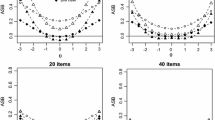Abstract
The item characteristic curve (ICC), defining the relation between ability and the probability of choosing a particular option for a test item, can be estimated by using polynomial regression splines. These provide a more flexible family of functions than is given by the three-parameter logistic family. The estimation of spline ICCs is described by maximizing the marginal likelihood formed by integrating ability over a beta prior distribution. Some simulation results compare this approach with the joint estimation of ability and item parameters.
Similar content being viewed by others
References
Abramowitz, M., & Stegun, I. A. (1964)Handbook of mathematical functions. New York: Dover.
Andersen, E. (1973). Conditional inference and multiple choice questionnaires.British Journal of Mathematical and Statistical Psychology, 26, 31–44.
Atkinson, A. C. (1979). A family of switching algorithms for the computer generation of beta random variates.Biometrika, 66, 141–145.
Bock, R. D., & Aitkin, M. (1981). Marginal maximum likelihood estimation of item parameters: Application of an EM algorithm.Psychometrika, 46, 443–459.
Bock, R. D., & Lieberman, M. (1970). Fitting a response model forn dichotomously scored items.Psychometrika, 35, 179–197.
Brieman, L., & Friedman, J. H. (1985). Estimating optimal transformations for multiple regression and correlation (with discussion).Journal of the American Statistical Association, 80, 580–618.
de Leeuw, J. (1988). Multivariate analysis with linearizable regressions.Psychometrika, 53, 437–454.
Drasgow, F., Levine, M. V., Williams, B., McLaughlin, M. E., & Candell, G. L. (1989). Modeling incorrect responses to multiple-choice items with multilinear formula score theory.Applied Psychological Measurement, 13, 285–299.
Golub, G. H., & Welsch, J. H. (1969). Calculation of Gauss quadrature rules.Mathematics of Computation, 23, 221–230.
Levine, M. V. (1984).An introduction to multilinear formula score theory (Measurement Series 84-5). Champaign, IL: University of Illinois, Department of Educational Psychology, Model-Based Measurement Laboratory.
Levine, M. V. (1985). The trait in latent trait theory. In D. J. Weiss (Ed.).Proceedings of the 1982 item response theory/ computerized adaptive testing conference (pp. 41–65). Minneapolis: University of Minnesota, Department of Psychology, Computerized Adaptive Testing Laboratory.
Lewis, C. (1986). Test theory andPsychometrika: The past twenty-five years,Psychometrika, 51, 11–22.
Lord, F. M. (1980).Applications of item response theory to practical testing problems. Hillsdale, NJ: Lawrence Erlbaum.
Mislevy, R. J., & Bock, R. D. (1982).BILOG: Item analysis and test scoring with binary logistic models [Computer Program]. Mooresville, IN: Scientific Software.
Press, W. H., Flannery, B. P., Teukolsky, S. A., & Vetterling, W. T. (1986).Numerical recipes: The art of scientific computing. Cambridge: Cambridge University Press.
Ramsay, J. O. (1988). Monotone regression splines in action (with discussion).Statistical Science, 3, 425–461.
Ramsay, J. O. (1989). A comparison of three simple test theory models.Psychometrika, 54, 487–499.
Ramsay, J. O., & Abrahjamowicz, M. (1989). Binomial regression with monotone splines: A psychometric application.Journal of the American Statistical Association, 84, 906–915.
Rasch, G. (1960).Probabilistic models for some intelligence and attainment tests. Copenhagen: Danmarks Paedagogiske Institut.
Samejima, F. (1977). A method of estimating item characteristic functions using the maximum likelihood estimate of ability.Psychometrika, 42, 161–191.
Samejima, F. (1979).A new family of models for the multiple choice item (Research Report No. 79-4). Knoxville: University of Tennessee, Department of Psychology.
Samejima, F. (1984).Plausibility functions of Iowa Vocabulary Test items estimated by the simple sum procedure of the conditional P.D.F. approach (Research Report No. 84-1). Knoxville: University of Tennessee, Department of Psychology.
Stoer, J., & Bulirsch, R. (1980).Introduction to numerical analysis. New York: Springer-Verlag.
Tibshirani, R. J. (1988). Estimating transformations for regression via additivity and variance stabilization.Journal of the American Statistical Association, 83, 394–405.
Winsberg, S., & Ramsay, J. O. (1980). Monotonic transformations to addivity using splines.Biometrika, 67, 669–674.
Winsberg, S., & Ramsay, J. O. (1983). Monotonic spline transformations for dimension reduction.Psychometrika, 48, 403–423.
Winsberg, S., Thissen, D., & Wainer, H. (1984).Fitting item characteristic curves with spline functions (Technical Report No. 84-52). Princeton, NJ, Educational Testing Service.
Author information
Authors and Affiliations
Additional information
IRCAM
The research reported in this paper was supported by Grants APA320 and A4035 from the Natural Sciences and Engineering Research Council of Canada. It was also supported by Contract No. F41689-82-C-10020 from the Air Force Human Resources Laboratory to Educational Testing Service. The author wishes to thank M. Abrahamowicz for his assistance and R. Darrell Bock for providing the parameters for the items used in the simulations.
Rights and permissions
About this article
Cite this article
Ramsay, J.O., Winsberg, S. Maximum marginal likelihood estimation for semiparametric item analysis. Psychometrika 56, 365–379 (1991). https://doi.org/10.1007/BF02294480
Received:
Revised:
Issue Date:
DOI: https://doi.org/10.1007/BF02294480




